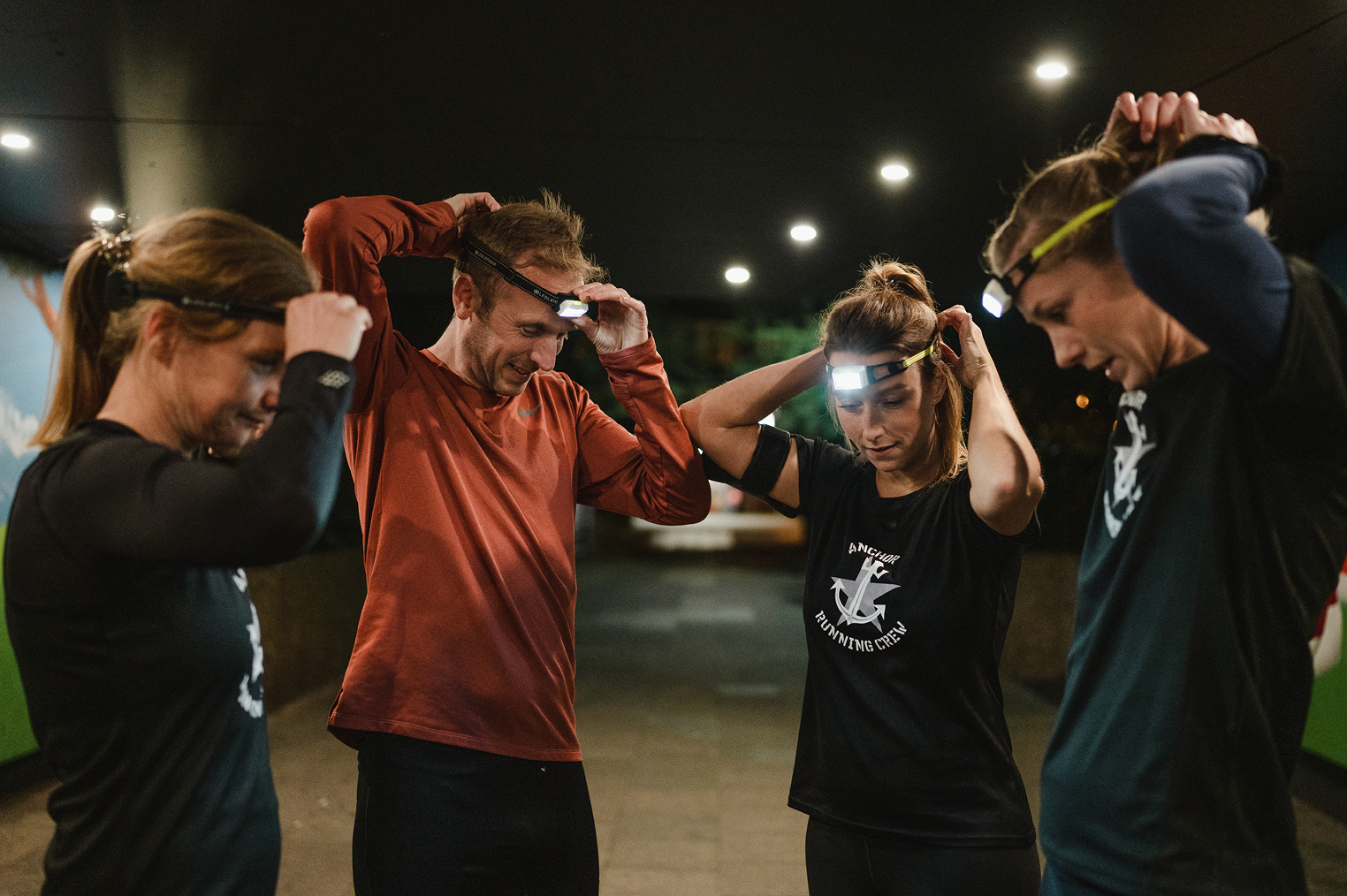When you set off on a city run in the evening, street lamps usually provide enough light - at least for you. When jogging in the city, however, a headlamp primarily ensures that you can be seen better. This means you can avoid accidents with other road users. In addition, you achieve even better illumination of the paths if the light from the street lamps is not sufficient. As a rule, a lightweight headlamp with 100 lumens is sufficient. A red rear light and a reflective headband are also useful.

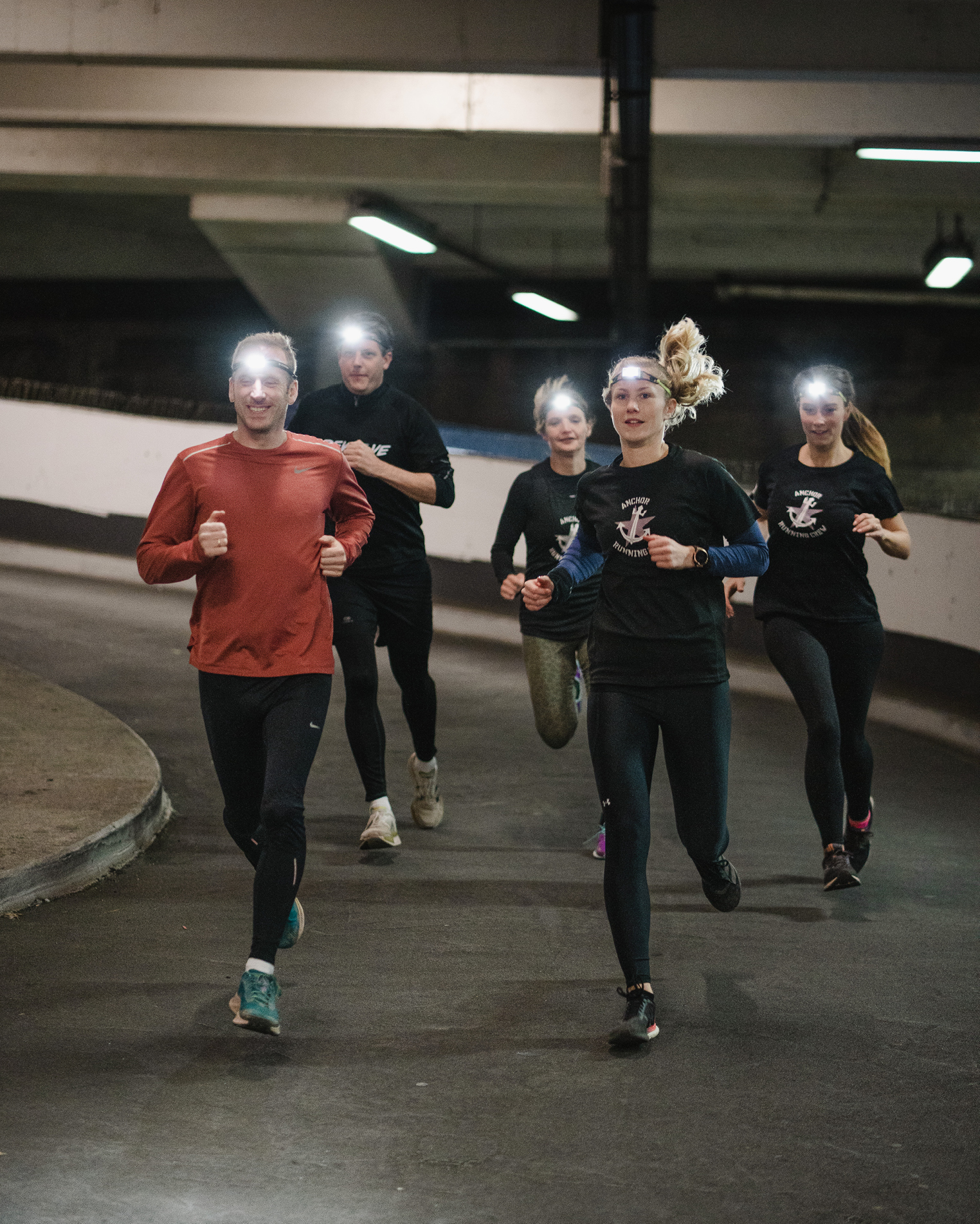
Why is a wearing a headlamp so important when jogging?
To see and to be seen – that should be your motto when you're jogging in the dark! Because the reason for wearing a headlamp isn't just to help you see better. Other runners and other people on the road, such as cyclists and car drivers, can also see you because you're wearing an LED lamp. This way, you can avoid accidents – after all, jogging is supposed make you healthier, not injure you. Wearing a headlamp is also good idea when running on lighted paths in the city. Many headlamps also have a light on both the front and the back. In any case, other people on the road will notice you much faster and you'll avoid collisions.
From your perspective, of course, a headlamp is very useful. You can see the path in front of you better and avoid tripping hazards. On dimly lit paths, and especially in complete darkness, you can always see where you're going. But isn't a flashlight good enough for jogging? Theoretically, you can also light your path with a regular flashlight. But if you do, then you can't move your arms the way you normally do when running. And if you trip, your hands won't be free to help break your fall. So, a flashlight is really a hindrance when jogging. A headlamp, on the other hand, always shines exactly where you're looking and also lights up your surroundings. This is a clear advantage!
What makes a good headlamp?
A good headlamp for jogging must fulfill various criteria. These include comfort and weight on the one hand, and light range, light intensity, light duration and light image on the other. It should sit comfortably but firmly on your head and illuminate your running route properly - and not give out after half an hour when you could run for another hour.
How powerful the light should be, how long it should last and how far the light from your new LED headlamp should shine when jogging depends entirely on the area of use. Where exactly do you run? Are the paths level, paved and well-lit or do you literally run over hill and dale in the dark in the forest? Are you more of a short-distance runner or do you enjoy a long run? All these points determine which headlamp is right for you for jogging and running.
How many lumens should a headlamp have for jogging?
You can tell how bright your lamp is by the luminous flux in lumens. The more lumens, the brighter the headlamp shines. Headlamps with 100 lumens or more are suitable for jogging to provide you with enough light. Make sure that your lamp also provides the appropriate luminous flux permanently and not just briefly in boost mode. Ledlenser headlamps are equipped with long-lasting LED lights and will get you safely through the dark. Depending on how well illuminated your running route is, you may need an LED lamp with more lumens. You can use these values as a guide:
- Illuminated city run: 100-150 lumens
- Running on poorly lit paths: 100-200 lumens
- Jogging on dark forest paths: 200-300 lumens
- Trail running and running off paved paths: more than 500 lumens
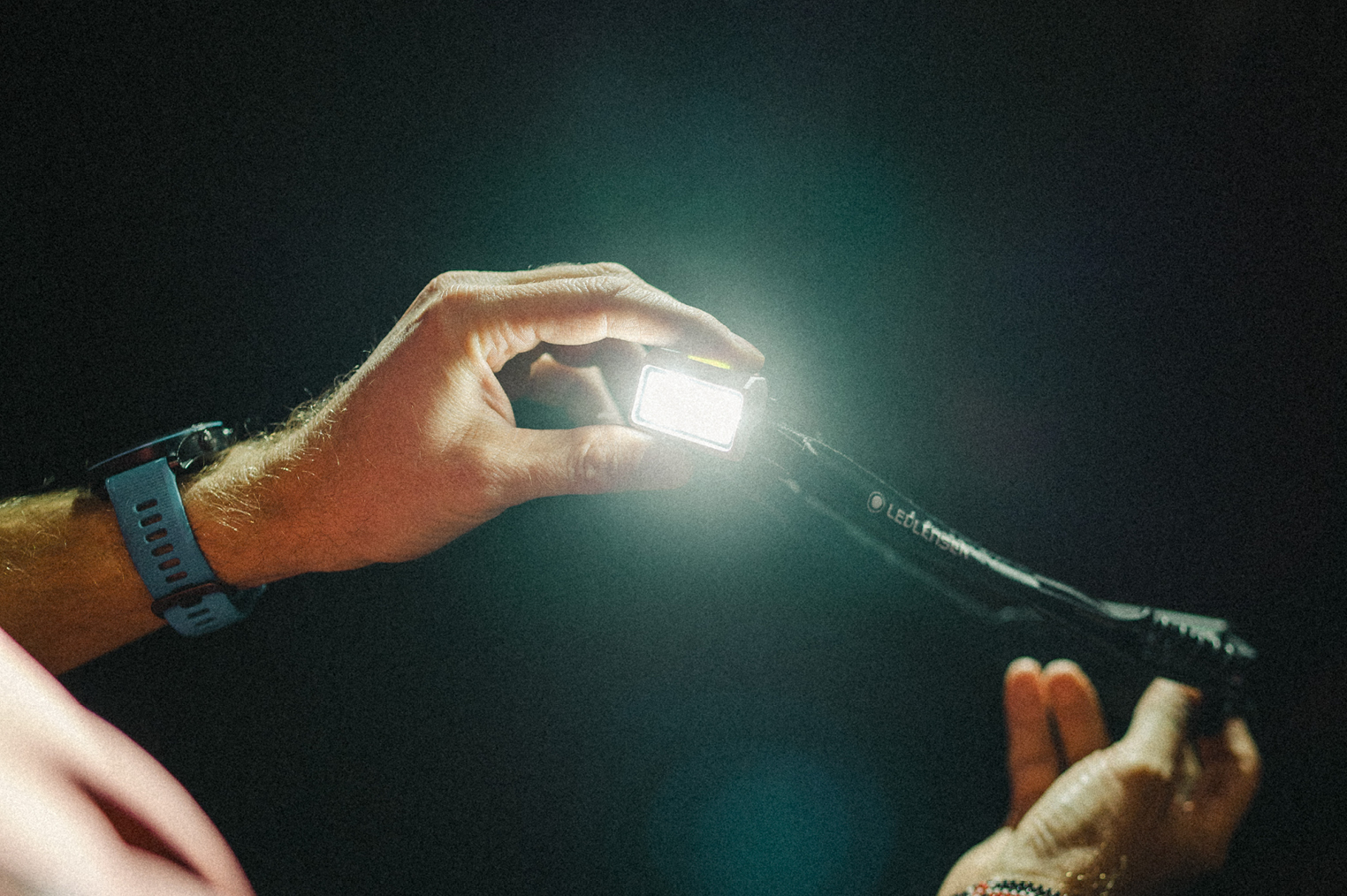
How important is the light pattern of a headlamp when jogging?
The light pattern is sometimes responsible for illuminating the path in front of you. The cone of light cast by the lamp widens towards the front. Depending on how wide the light cone of your LED lamp is, you can not only see the path in front of you, but also next to you. The forward focus is important in order to be able to run with foresight. However, you should also be able to see everything directly in front of and next to you when jogging to avoid tripping over obstacles. A pure spot light is therefore rather unsuitable for running in the dark.
The headlamps from Ledlenser's NEO series offer perfect illumination for your running route thanks to Fusion Beam technology. The combination of different LEDs and lenses enables homogeneous close-range light and focused long-range light at the same time. So you always have an overview!
The best thing about it: The different dimming levels of the individual LEDs allow you to adjust the brightness of your Ledlenser headlamp individually to your needs and your running route while jogging. Our Ledlenser headlamps for joggers are also equipped with a tilt function. This means you can set the light higher or lower from the outset without having to move your head.
Does the headlamp need to be waterproof for running?
As your headlamp is particularly useful for jogging in the colder and darker months of the year, it should definitely offer protection against splashing water. After all, rain and snow are not uncommon at this time of year and should not stop you from training in the fresh air. Early morning fog can also be a problem for a running lamp that is not waterproof. Therefore, when buying your new running headlamp, pay attention to the IPX certification. This indicates the level of protection against water. IPX0 stands for no protection against water, IPX8 means waterproof even when submerged for long periods.
A headlamp with IPX4 is sufficient for jogging in the fall and winter. However, headlamps with a higher protection class are of course also suitable. You can find out more about IP protection classes in our "Waterproof flashlights" guide.
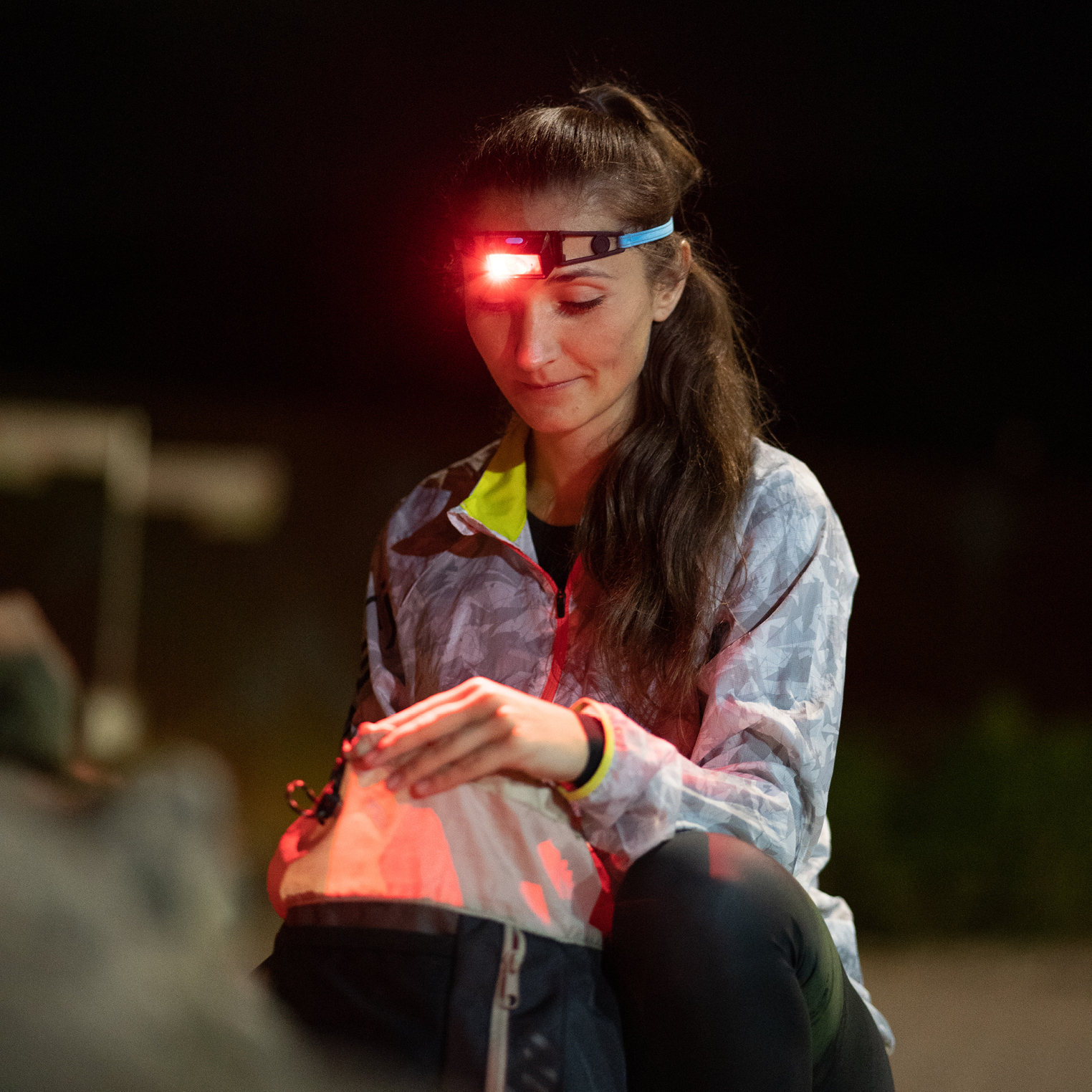
What is the benefit of red light in headlamps?
In addition to the main white light, many headlamps also have a red light. Red light is less dazzling than white light and maintains night vision. This means that if you first switch the light on in the dark and then switch it off again, your eyes do not have to get used to the darkness again when the light turns red. This is very practical if, for example, you are out and about in the dark and want to take a look at the map or if you have to get up again at night when camping and don't want to dazzle your tent neighbor. However, as you can't switch between light and dark when running because you have to see the path in front of you the whole time, red light is not a feature that your running lamp absolutely has to have.
Lithium-ion batteries or standard batteries: which are better for headlamps?
The choice between rechargeable and battery is a personal one. A headlamp with a rechargeable battery can be charged before jogging using a USB cable. This allows you to bring light into the dark while running with a fully charged battery. It is also more sustainable because rechargeable batteries can be used for a very long time. The disadvantage: A headlamp for jogging with a rechargeable battery usually weighs more than the same lamp with batteries. On the other hand, with a headlamp with batteries you always have to check before running whether the remaining light duration is still sufficient for your running route. However, you have the option of taking spare batteries with you and changing them if they run out. This is not possible with a lamp with a permanently installed rechargeable battery.
Our Ledlenser NEO9R headlamp, which was specially developed for trail running, offers a compromise. It is equipped with replaceable rechargeable batteries. With a spare battery, you always have enough light with you to illuminate the path ahead of you, even on longer tours.
In general, you should pay attention to the light duration before buying - regardless of whether a fixed rechargeable battery or a battery compartment is installed. LED headlamps with high luminosity consume a lot of power and have a comparatively short burn time. With 500-600 lumens, you can expect approx. 4-5 hours of illumination at maximum brightness, depending on the size of the battery. If you turn down the light intensity, the lamp will stay bright for longer. Smaller headlamps with 100 lumens achieve a battery life of around 10 hours at maximum brightness. If you turn it down to 20 lumens, it will even illuminate your running route for around 40 hours.
Tip: With many headlamps for jogging, the LED lamp is attached to the front of the headband, with the rechargeable battery or battery compartment at the back - as is the case with almost all of our jogging headlamps. This ensures optimum weight distribution. Headlamps with high luminosity require a powerful rechargeable battery or several batteries, which results in a higher weight. Comfortable weight distribution is particularly important with these LED lamps. There are even models such as the NEO9R that outsource the power source. Thanks to the extension cable supplied, you can stow the battery separately in your jacket pocket, for example.
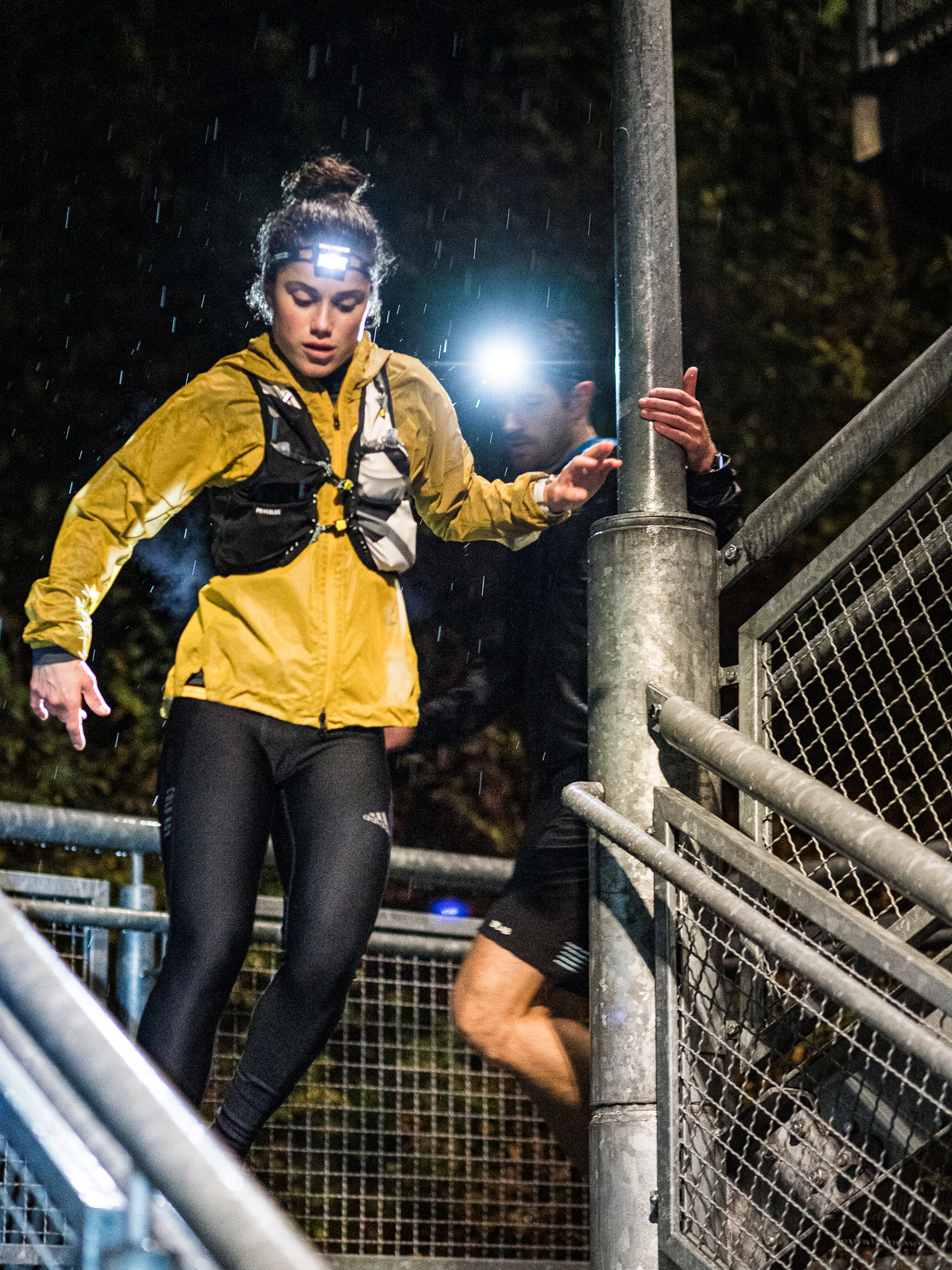
Which headlamp is the best for jogging?
For jogging, you should choose a lightweight headlamp with a brightness of at least 100 lumens. If you tend to run in darker conditions, you can opt for more lumens. However, the brighter your headlamp, the more likely it is that you will blind oncoming runners, cyclists or motorists. So be sure to point the beam of your headlamp slightly towards the ground when someone is approaching you. Special models even have an integrated glare shield that gives you the best view and doesn't blind the other people on the road.
Most headlamps have different light levels so you can adjust the brightness. With some models, you can set the light levels directly on the lamp, with others, you can set the light levels remotely via an app or by remote control. For maximum safety, you should choose a jogging headlamp with a rear light, so that the other people on the road can see you.
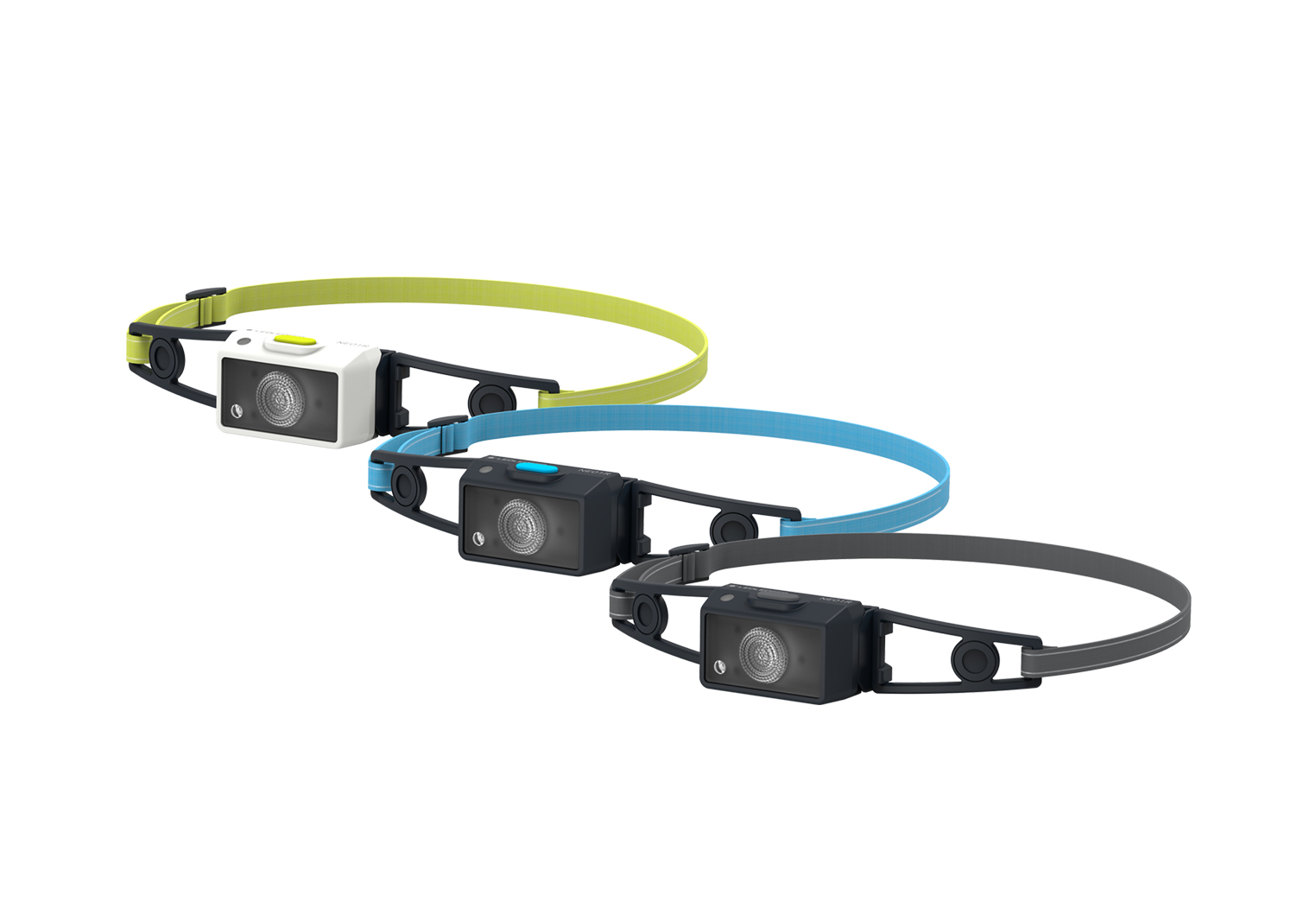
NEO1R: Super light and compact
The NEO1R is our lightest and smallest running light. The rechargeable headlamp is ideal as a backup lamp that you can always have with you in case you are surprised by dusk while running. With its 150 lumens in power mode and up to 250 lumens in boost mode for short periods, it is the perfect model for joggers who are out and about in urban areas, want to run a lap through the park or around the lake. It has a combined flood and spot lens, allowing you to illuminate both the path in the distance and the close range. Thanks to its red light and IP67 protection, it can also be used as an outdoor headlamp.
- Luminous flux: up to 250 lumens (boost)
- Lighting range: up to 80 meters (boost)
- Lighting duration: up to 15 hours (low power)
- Weight: 39 grams
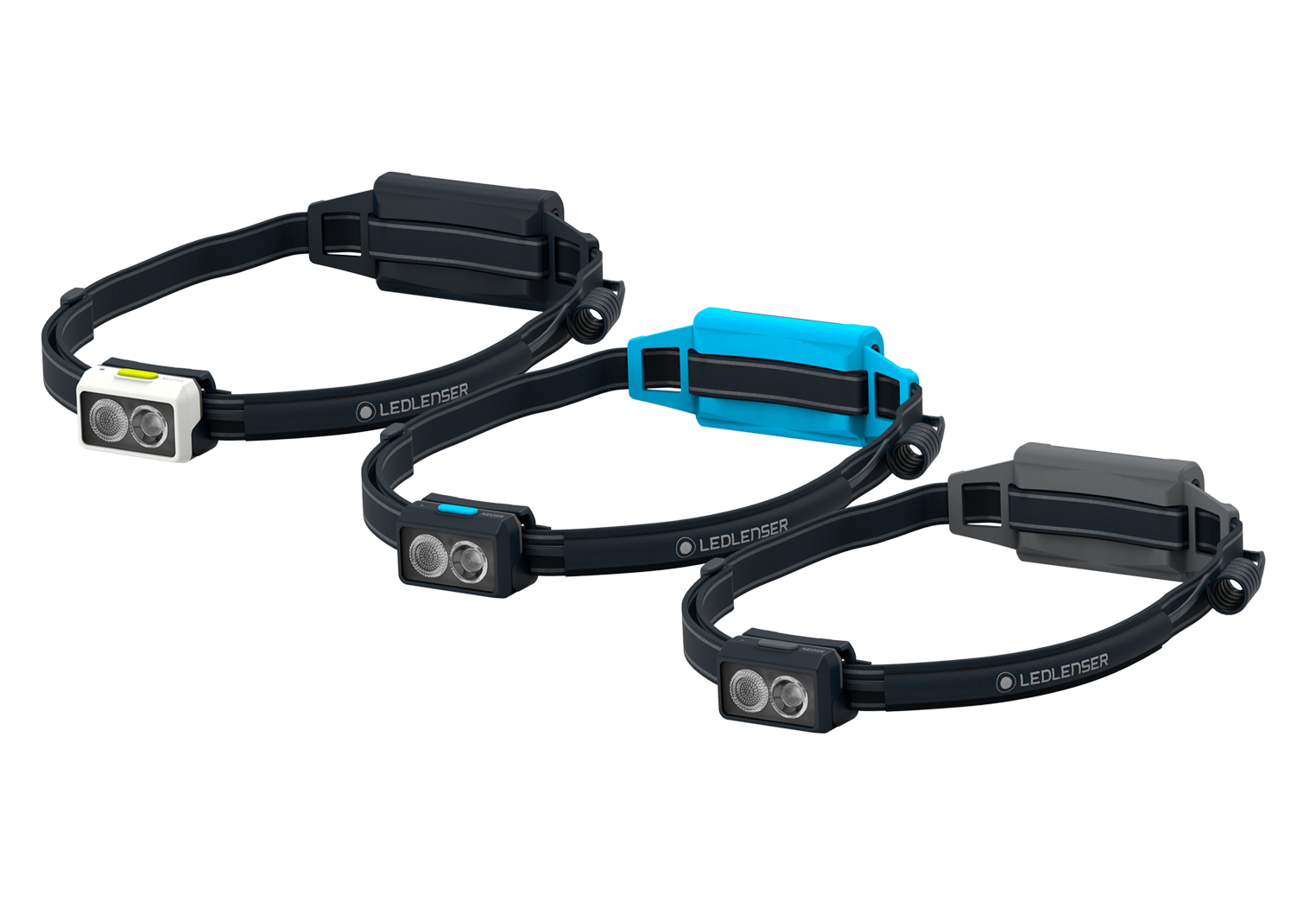
NEO3: Our entry-level model for demanding runners
If you are also out and about in areas that are less well lit, then you need a running lamp with more power such as our NEO3 with 200 lumens in power mode and up to 400 lumens in boost mode (for approx. 10 seconds). This model is powered by 3 AAA batteries and is very light compared to headlamps with similar power, weighing less than 100 grams. The battery compartment is located at the back of the head for better weight distribution and comfort. It has two separate lenses, one for long range and one for close range. Thanks to the red flashing rear light, you can also be seen very well from behind, which is particularly important in road traffic.
- Luminous flux: up to 400 lumens (boost)
- Light range: up to 80 meters (boost)
- Lighting duration: up to 20 hours (low power)
- Weight: 97 grams
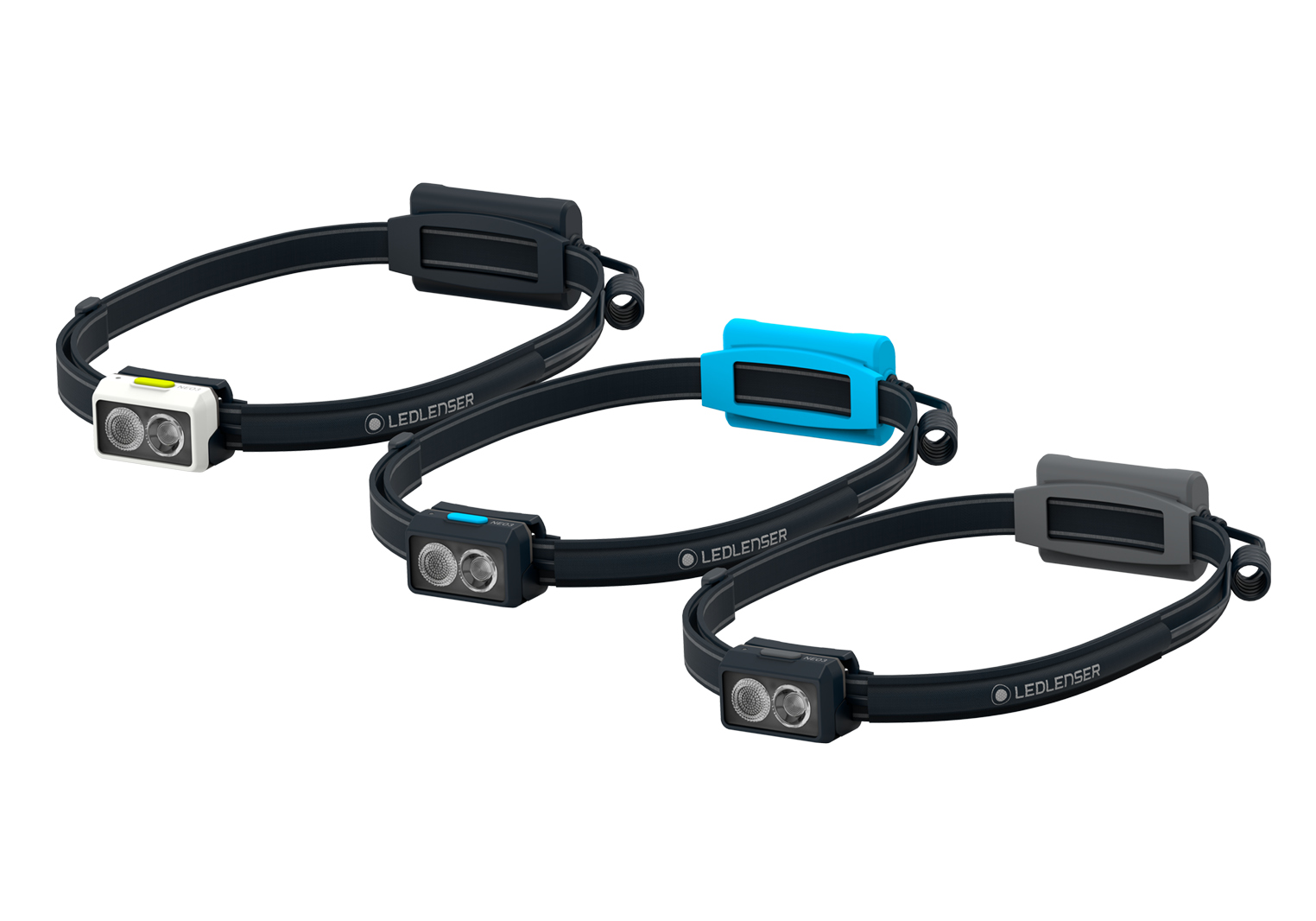
NEO5R: Powerful rechargeable running light
The NEO5R has a similar design to the NEO3, but is powered by a rechargeable battery. This makes it a little heavier, but it also has a higher luminous flux of 300 lumens in power mode and up to 600 lumens in boost mode for short periods. This makes it the ideal running light for dark routes, such as unlit forest paths, and longer laps. It also has a light pattern optimized for running, an integrated red rear light and its battery is also located at the back of the head for better weight distribution. A chest strap is also included if you prefer to wear your light on your chest rather than on your head.
- Luminous flux: up to 600 lumens (boost)
- Lighting range: up to 100 meters (boost)
- Lighting duration: up to 35 hours (low power)
- Weight: 104 grams
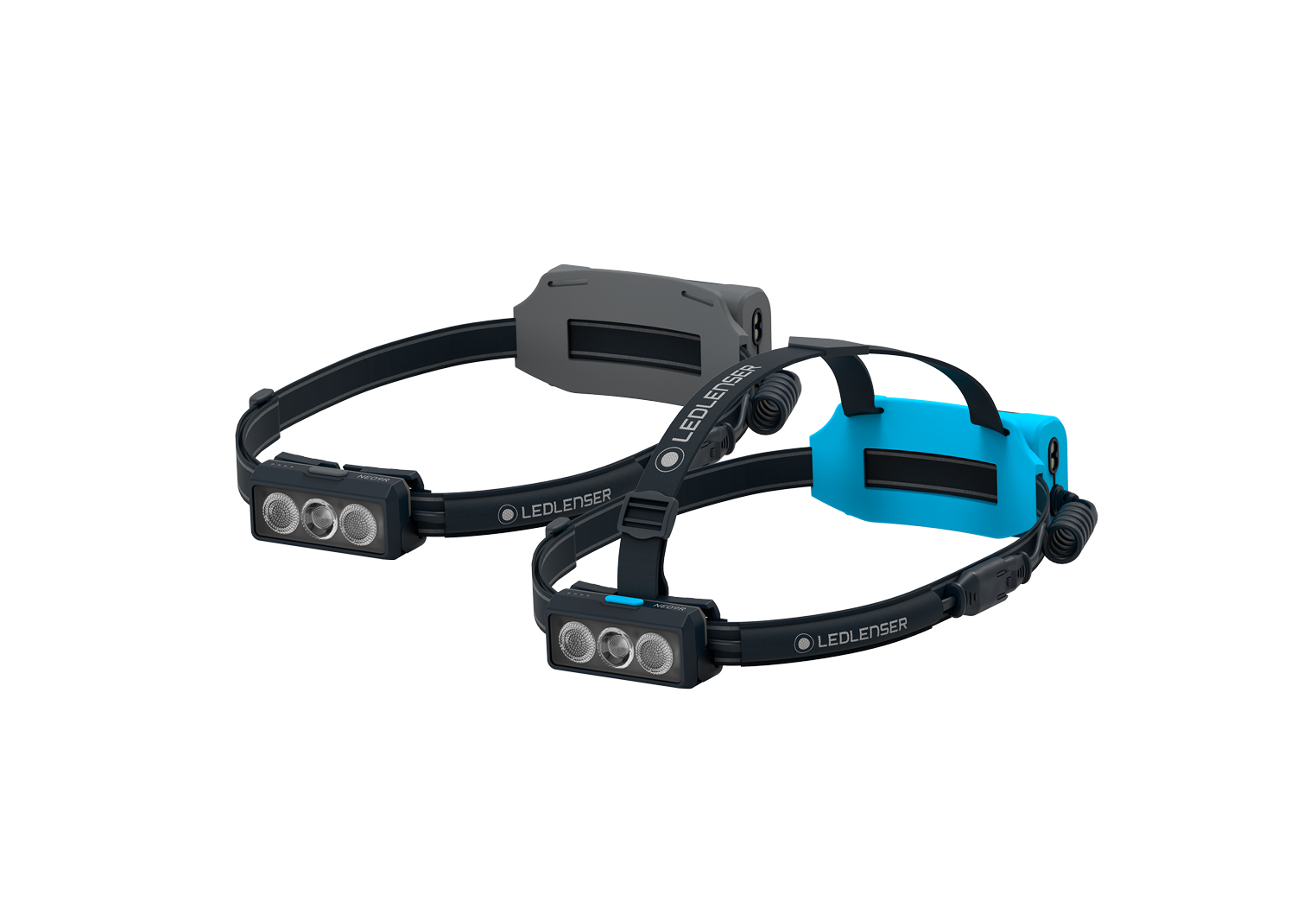
NEO9R: Powerhouse for trail runners
The NEO9R is the most powerful running light in our NEO series and is designed to meet the needs of trail runners. With 600 lumens in power mode and up to 1200 lumens in boost mode, it is also suitable for runs in rough terrain where it is important to illuminate the route ahead down to the smallest detail. Its replaceable battery lasts a full 5 hours in power mode. If this is not enough for you, you can double the running time to 10 hours with a replacement battery. Despite this enormous power, the lamp weighs less than 200 grams, which is very light compared to similarly powerful headlamps. The battery is also located at the back of the head for better weight distribution and it has an overhead strap. You also have the option of putting the battery in a rucksack or bag thanks to the extension cable if you want to carry less weight on your head. Or you can use the chest strap supplied and wear the lamp on your chest.
- Luminous flux: up to 1200 lumens (boost)
- Lighting range: up to 200 meters (boost)
- Light duration: up to 120 hours (low power)
- Weight: 199 grams
In summary: How do I find the right jogging headlamp?
To find the right headlamp for you and your jogging style, you should consider the following points:
- Wearing comfort: the most important point is wearing comfort. The headlamp can have great range of illumination or a long battery life, but if it doesn't fit you and if it slips or fits too tightly when jogging, then it's not the right lamp for you.
- Running route: where do you go running when it's dark outside? Do you run in the city on lighted, paved paths or do you like to run in the woods? Your jogging headlamp will need more or less lumens depending on where you run. If you always run on different paths, you can also choose a headlamp with different light levels. This way, you can always adjust the brightness of your running headlamp to your surroundings.
- Weight: Think about whether you want to carry the weight of the rechargeable battery or batteries on your head, especially for headlamps with a high light output. Although the power source for such heavy headlamps is usually attached to the back of the headband, this can still be annoying for you. There are also models with a separate rechargeable battery that can be carried in your pocket using an extension cable. A chest strap can also be an alternative to a headband.

- Rear light: If your running route takes you through areas where there are lots of other joggers or road users, a headlamp with a rear light can't hurt. This means you can be seen at all times not only from the front but also from behind and can avoid accidents. Reflective elements on the headband also increase your visibility.
- Water protection: Think about how waterproof you want your new running headlamp to be. Your headlamp for jogging should always be protected from splashing water as a minimum! Even if you tend not to go out in the rain, the humidity in winter is quite high. Even fog can be fatal for your lamp without splash protection.
- Battery life: The higher the light intensity of your headlamp, the shorter the battery life. Therefore, when buying your new headlamp for jogging, pay attention to the light duration. It should suit you and your running habits.
- Extras: Some models come up trumps with cool extras. For example, the light intensity can be controlled via app or remote control or the lamp can save your last settings. Such extras are practical, but are also reflected in the price.
Browse our store and find the right headlamp for you and for your training in winter!
More questions about the best headlamps for jogging
If your running route is on dimly lit or unlit paths, where the ground is solid, you'll need a brighter headlamp. In this case, up to 300 lumens should be enough when running with a headlamp. Of course, a rear light is important here too. If you're running on bike paths or in unlit parks, you may encounter other other people at any time.
Always be careful when jogging in the forest - especially in the dark. Roots, stones or fallen branches can turn the already uneven path in front of you into a real tripping hazard. That's why it's important that your LED headlamp offers high luminosity and a long range when jogging in the forest. This allows you to see the path directly in front of you, but also at a distance of 50-100 meters. Your headlamp should therefore have at least 300 lumens. This means that running ahead in the forest in the dark is no problem.
When trail running cross-country, your headlamp must meet special requirements. Because you're moving on uneven, unpaved terrain. You often don't decide which path you're going to take next until the last moment. To ensure that nothing gets in the way of your jogging adventure even in winter, you need a very bright and robust running headlamp. The illumination range should be at least 100 meters, so you can clearly see everything in front of you. A 500-lumen running lamp can give you enough light, but you may need even more luminosity. In this case, you can't rely on a lightweight jogging headlamp. The high luminosity requires a lot of battery power, which naturally adds to the weight.
